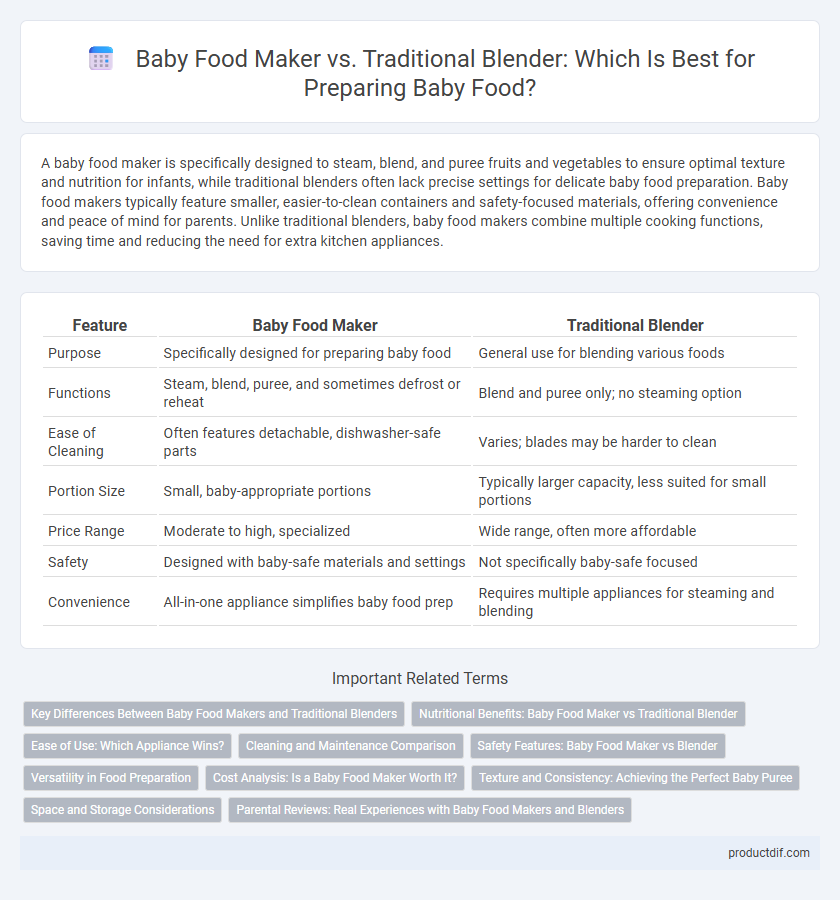A baby food maker is specifically designed to steam, blend, and puree fruits and vegetables to ensure optimal texture and nutrition for infants, while traditional blenders often lack precise settings for delicate baby food preparation. Baby food makers typically feature smaller, easier-to-clean containers and safety-focused materials, offering convenience and peace of mind for parents. Unlike traditional blenders, baby food makers combine multiple cooking functions, saving time and reducing the need for extra kitchen appliances.
Table of Comparison
| Feature | Baby Food Maker | Traditional Blender |
|---|---|---|
| Purpose | Specifically designed for preparing baby food | General use for blending various foods |
| Functions | Steam, blend, puree, and sometimes defrost or reheat | Blend and puree only; no steaming option |
| Ease of Cleaning | Often features detachable, dishwasher-safe parts | Varies; blades may be harder to clean |
| Portion Size | Small, baby-appropriate portions | Typically larger capacity, less suited for small portions |
| Price Range | Moderate to high, specialized | Wide range, often more affordable |
| Safety | Designed with baby-safe materials and settings | Not specifically baby-safe focused |
| Convenience | All-in-one appliance simplifies baby food prep | Requires multiple appliances for steaming and blending |
Key Differences Between Baby Food Makers and Traditional Blenders
Baby food makers offer specialized features such as steaming, blending, and reheating in one device, ensuring nutrient retention and optimal texture for infant consumption. Traditional blenders provide powerful blending capabilities but lack functions tailored for baby food preparation, often requiring additional cookware for steaming or reheating. Baby food makers simplify meal prep with precise portion control and easy cleaning, while traditional blenders serve broader culinary purposes without customization for babies.
Nutritional Benefits: Baby Food Maker vs Traditional Blender
Baby food makers are specifically designed to preserve maximum nutrients through gentle steaming and precise blending, which helps maintain vitamins and minerals essential for infant development. Traditional blenders often generate heat and create oxidation during blending, potentially reducing nutrient quality in homemade baby food. Choosing a baby food maker ensures better retention of natural flavors and bioavailability of nutrients critical for baby's growth.
Ease of Use: Which Appliance Wins?
Baby food makers often outperform traditional blenders in ease of use due to their specialized design with preset functions for steaming and pureeing, streamlining meal prep for busy parents. These appliances frequently feature one-touch controls and built-in timers, reducing the need for manual monitoring and multiple steps. Traditional blenders require more hands-on operation and additional cooking equipment, making baby food makers the preferred choice for effortless and efficient baby food preparation.
Cleaning and Maintenance Comparison
Baby food makers offer streamlined cleaning with dishwasher-safe components designed specifically to handle pureed foods, reducing lingering odors and residue. Traditional blenders often require more meticulous disassembly and manual scrubbing to achieve thorough cleanliness, increasing time and effort. The compact design and dedicated attachments of baby food makers enhance ease of maintenance compared to multi-purpose blenders.
Safety Features: Baby Food Maker vs Blender
Baby food makers are designed with specialized safety features such as BPA-free materials, locked lids to prevent spills, and temperature controls to ensure gentle cooking suitable for infants. Traditional blenders often lack child-specific safety mechanisms, posing a higher risk of overheating and accidental injuries due to exposed blades. Choosing a baby food maker enhances safety by combining precise cooking functions with secure operation, tailored for preparing nutritious meals for babies.
Versatility in Food Preparation
Baby food makers offer enhanced versatility in food preparation by combining steaming, blending, and reheating functions into one compact device, enabling parents to prepare a wide range of purees, mashed foods, and even small portions of cooked meals. Traditional blenders, while capable of blending ingredients smoothly, lack integrated cooking features and may require additional equipment for steaming or reheating, limiting their multifunctionality. The all-in-one design of baby food makers streamlines the preparation process, making them ideal for creating varied textures and nutrient-rich meals tailored to a baby's developmental stages.
Cost Analysis: Is a Baby Food Maker Worth It?
Baby food makers typically range from $50 to $150, offering convenient steaming, blending, and reheating functions specifically designed for infants' nutritional needs, whereas traditional blenders cost between $30 and $200 but lack specialized features like recipe presets and safety locks. Investing in a baby food maker can save time and reduce the need for multiple kitchen appliances, potentially justifying the initial higher cost for parents prioritizing efficiency and tailored baby food preparation. The long-term value depends on frequency of use and preference for homemade baby food versus store-bought alternatives.
Texture and Consistency: Achieving the Perfect Baby Puree
Baby food makers deliver finely textured purees with consistent smoothness, essential for newborns' delicate digestive systems. Unlike traditional blenders, these appliances often combine steaming and blending, preserving nutrients while achieving uniform consistency. Consistent puree texture supports easier swallowing and gradual introduction of solids during infancy.
Space and Storage Considerations
Baby food makers are specifically designed with compact sizes and built-in storage compartments, optimizing kitchen space and reducing clutter compared to traditional blenders. Many models offer stackable components and detachable parts that fit neatly in small cabinets or countertops, making them ideal for limited spaces. In contrast, traditional blenders often have larger footprints and lack specialized storage solutions, which can lead to more cumbersome kitchen organization.
Parental Reviews: Real Experiences with Baby Food Makers and Blenders
Parents consistently highlight the convenience and safety features of baby food makers compared to traditional blenders, emphasizing preset programs and easy cleaning as key benefits. Many reviews note that baby food makers produce smoother purees ideal for infants while traditional blenders may struggle with texture control. Real experiences also reveal that dedicated baby food devices often streamline meal prep, saving time amid busy family routines.
Baby food maker vs traditional blender Infographic

 productdif.com
productdif.com